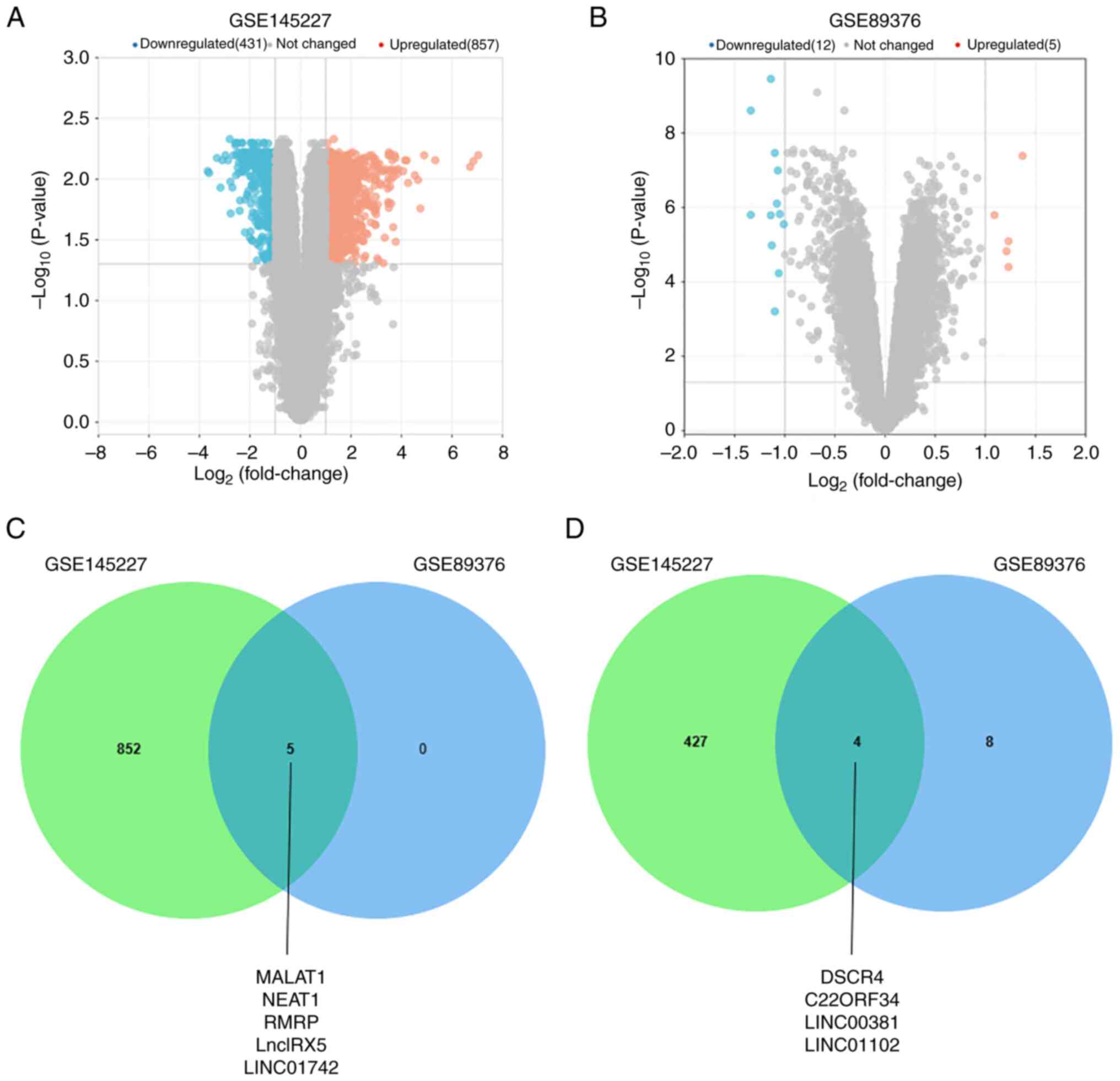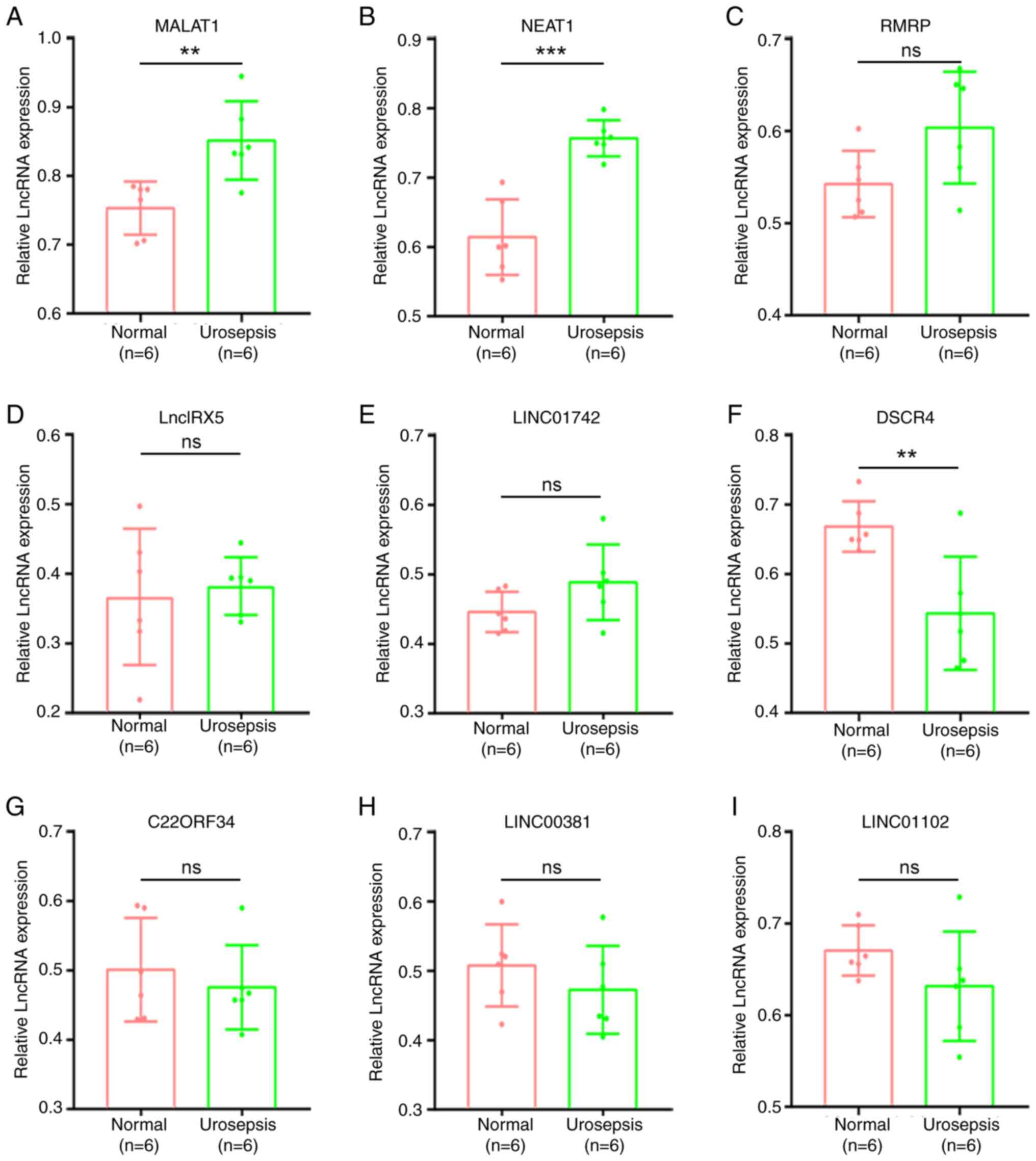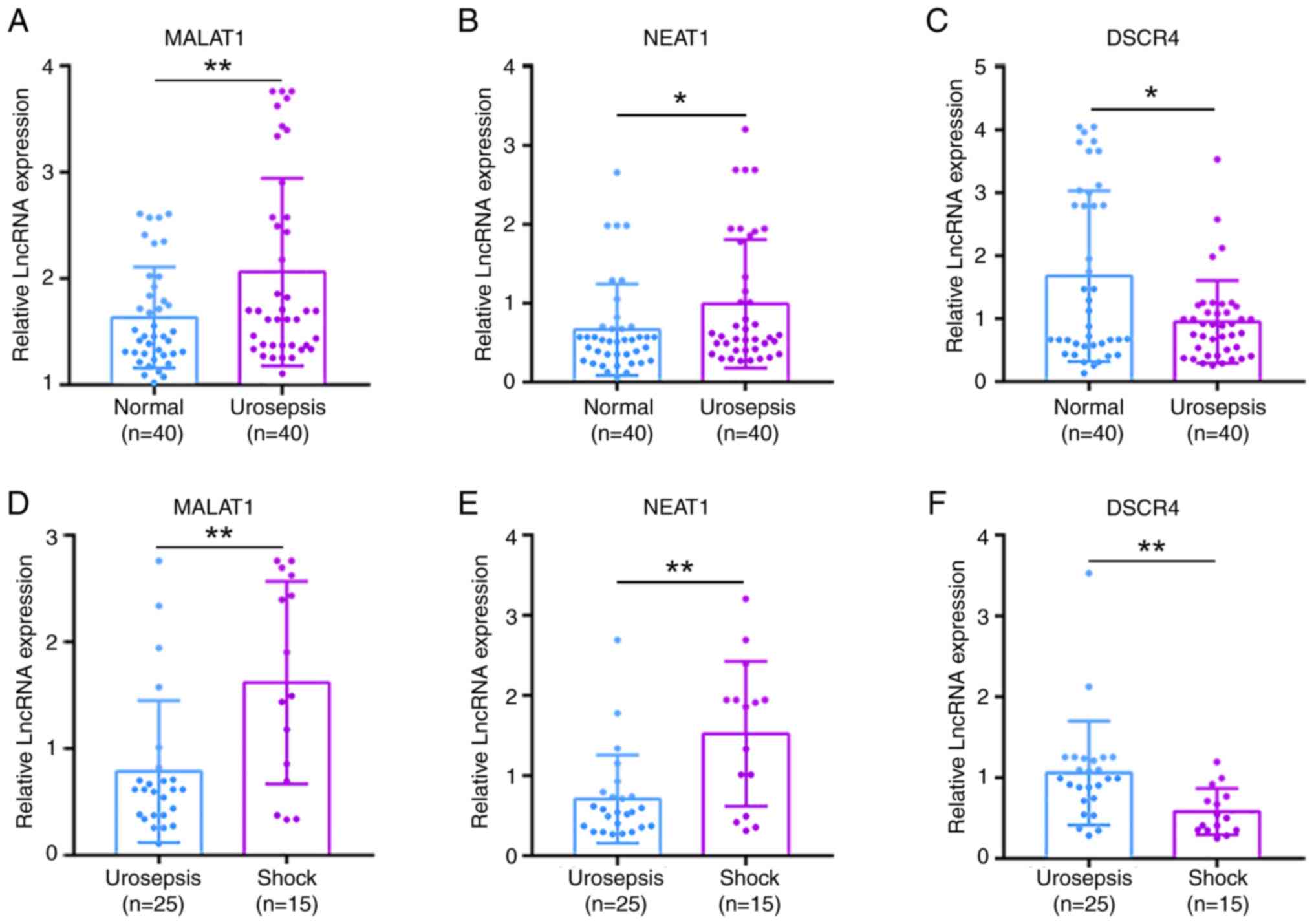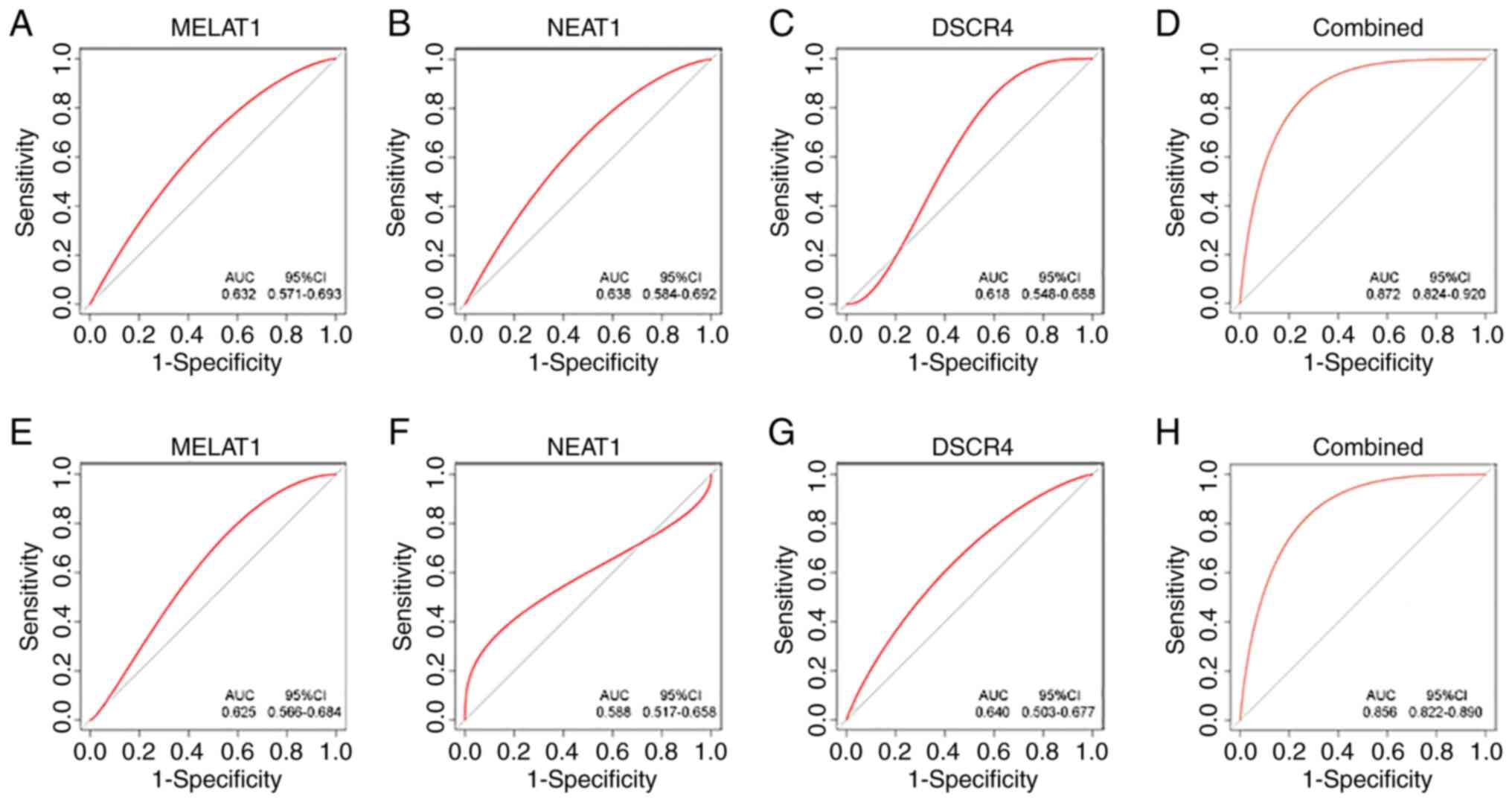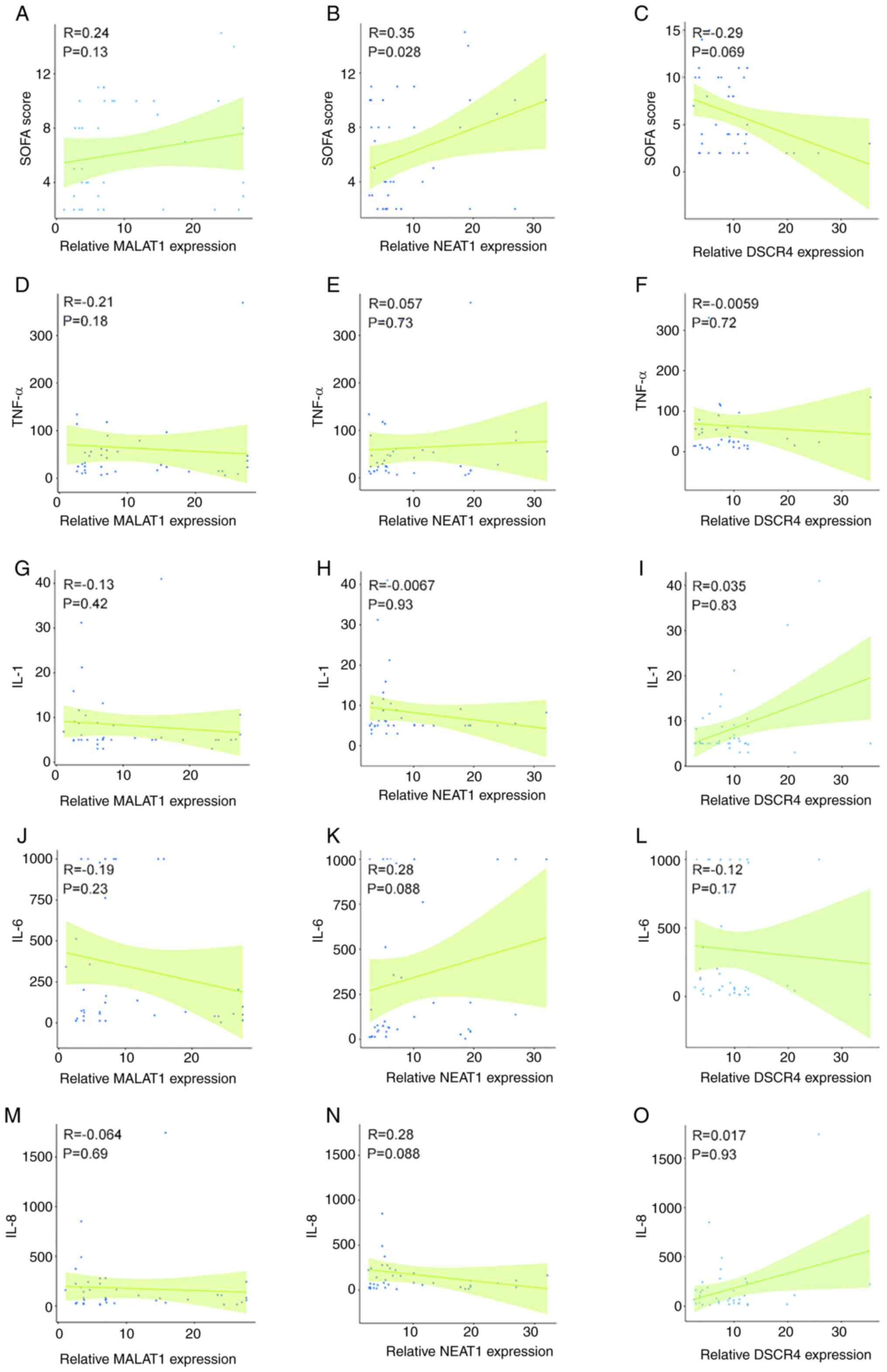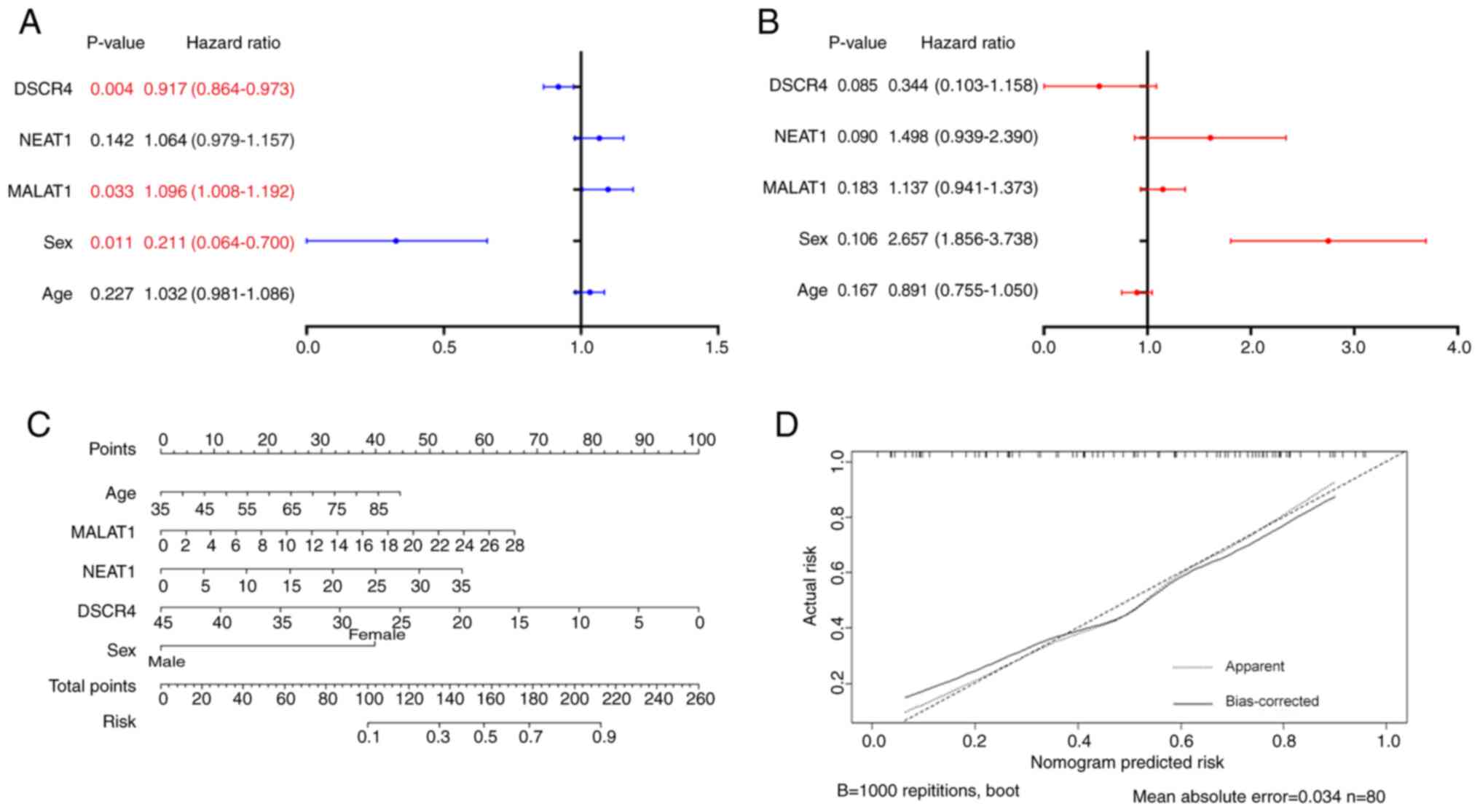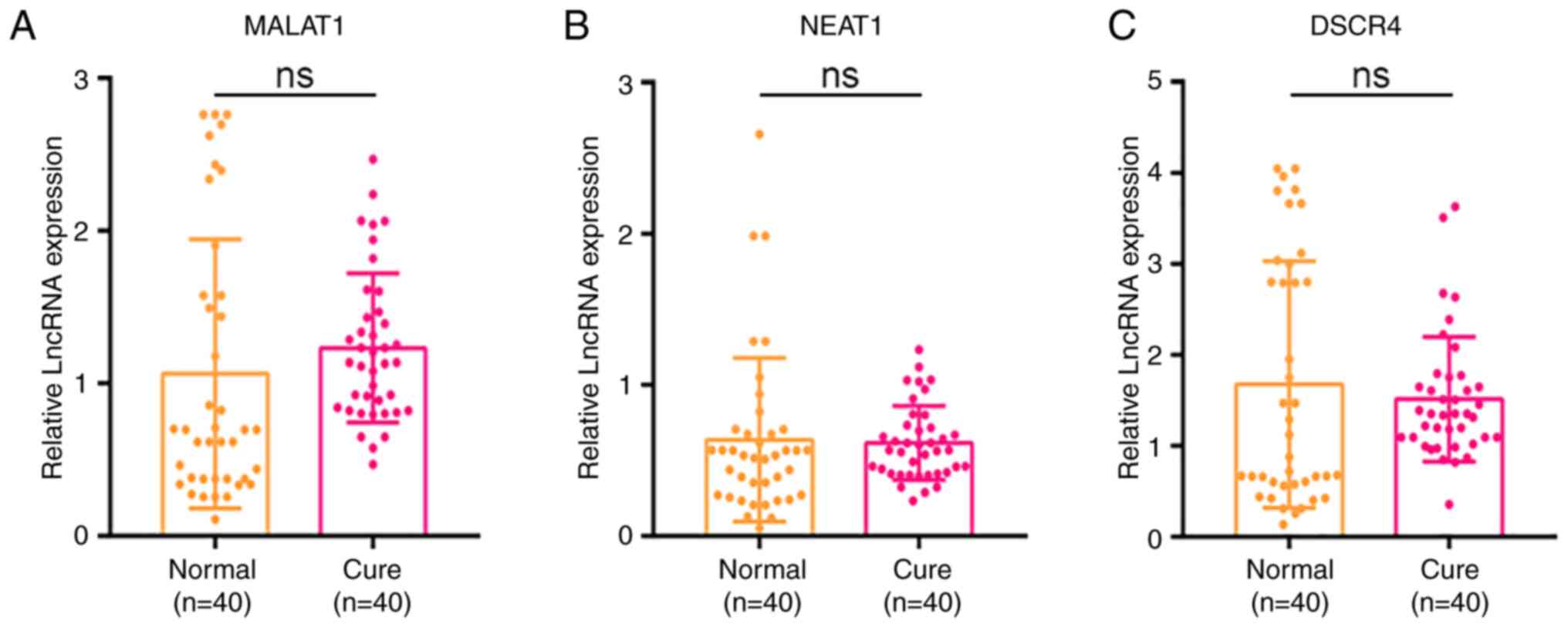|
1
|
Cecconi M, Evans L, Levy M and Rhodes A:
Sepsis and septic shock. Lancet. 392:75–87. 2018.PubMed/NCBI View Article : Google Scholar
|
|
2
|
Levy MM, Artigas A, Phillips GS, Rhodes A,
Beale R, Osborn T, Vincent JL, Townsend S, Lemeshow S and Dellinger
RP: Outcomes of the surviving sepsis campaign in intensive care
units in the USA and Europe: A prospective cohort study. Lancet
Infect Dis. 12:919–924. 2012.PubMed/NCBI View Article : Google Scholar
|
|
3
|
Wagenlehner FM, Lichtenstern C, Rolfes C,
Mayer K, Uhle F, Weidner W and Weigand MA: Diagnosis and management
for urosepsis. Int J Urol. 20:963–970. 2013.PubMed/NCBI View Article : Google Scholar
|
|
4
|
Bonkat G, Cai T, Veeratterapillay R,
Bruyère F, Bartoletti R, Pilatz A, Köves B, Geerlings SE, Pradere
B, Pickard R and Wagenlehner FME: Management of urosepsis in 2018.
Eur Urol Focus. 5:5–9. 2019.PubMed/NCBI View Article : Google Scholar
|
|
5
|
Gao X, Lu C, Xie F, Li L, Liu M, Fang Z,
Wang Z, Ming S, Dong H, Shen R, et al: Risk factors for sepsis in
patients with struvite stones following percutaneous
nephrolithotomy. World J Urol. 38:219–229. 2020.PubMed/NCBI View Article : Google Scholar
|
|
6
|
Wollin DA, Joyce AD, Gupta M, Wong MYC,
Laguna P, Gravas S, Gutierrez J, Cormio L, Wang K and Preminger GM:
Antibiotic use and the prevention and management of infectious
complications in stone disease. World J Urol. 35:1369–1379.
2017.PubMed/NCBI View Article : Google Scholar
|
|
7
|
Singer M, Deutschman CS, Seymour CW,
Shankar-Hari M, Annane D, Bauer M, Bellomo R, Bernard GR, Chiche
JD, Coopersmith CM, et al: The third international consensus
definitions for sepsis and septic shock (sepsis-3). JAMA.
315:801–810. 2016.PubMed/NCBI View Article : Google Scholar
|
|
8
|
Iyer MK, Niknafs YS, Malik R, Singhal U,
Sahu A, Hosono Y, Barrette TR, Prensner JR, Evans JR, Zhao S, et
al: The landscape of long noncoding RNAs in the human
transcriptome. Nat Genet. 47:199–208. 2015.PubMed/NCBI View
Article : Google Scholar
|
|
9
|
Rinn JL and Chang HY: Genome regulation by
long noncoding RNAs. Annu Rev Biochem. 81:145–166. 2012.PubMed/NCBI View Article : Google Scholar
|
|
10
|
Bhan A, Soleimani M and Mandal SS: Long
noncoding RNA and cancer: A new paradigm. Cancer Res. 77:3965–3981.
2017.PubMed/NCBI View Article : Google Scholar
|
|
11
|
Yong H, Wu G, Chen J, Liu X, Bai Y, Tang
N, Liu L and Wei J: lncRNA MALAT1 accelerates skeletal muscle cell
apoptosis and inflammatory response in sepsis by decreasing BRCA1
expression by recruiting EZH2. Mol Ther Nucleic Acids. 19:97–108.
2020.PubMed/NCBI View Article : Google Scholar
|
|
12
|
Xia D, Yao R, Zhou P, Wang C, Xia Y and Xu
S: LncRNA NEAT1 reversed the hindering effects of miR-495-3p/STAT3
axis and miR-211/PI3K/AKT axis on sepsis-relevant inflammation. Mol
Immunol. 117:168–179. 2020.PubMed/NCBI View Article : Google Scholar
|
|
13
|
Han Y, Cai Y, Lai X, Wang Z, Wei S, Tan K,
Xu M and Xie H: lncRNA RMRP prevents mitochondrial dysfunction and
cardiomyocyte apoptosis via the miR-1-5p/hsp70 axis in LPS-induced
sepsis mice. Inflammation. 43:605–618. 2020.PubMed/NCBI View Article : Google Scholar
|
|
14
|
Qiu N, Xu X and He Y: LncRNA TUG1
alleviates sepsis-induced acute lung injury by targeting
miR-34b-5p/GAB1. BMC Pulm Med. 20(49)2020.PubMed/NCBI View Article : Google Scholar
|
|
15
|
Na L, Ding H, Xing E, Gao J, Liu B, Wang
H, Yu J and Yu C: Lnc-MEG3 acts as a potential biomarker for
predicting increased disease risk, systemic inflammation, disease
severity, and poor prognosis of sepsis via interacting with miR-21.
J Clin Lab Anal. 34(e23123)2020.PubMed/NCBI View Article : Google Scholar
|
|
16
|
Gauthier J, Vincent AT, Charette SJ and
Derome N: A brief history of bioinformatics. Brief Bioinform.
20:1981–1996. 2019.PubMed/NCBI View Article : Google Scholar
|
|
17
|
Han M, Wang Y, Huang X, Li P, Shan W, Gu
H, Wang H, Zhang Q and Bao K: Prediction of biomarkers associated
with membranous nephropathy: Bioinformatic analysis and
experimental validation. Int Immunopharmacol.
126(111266)2024.PubMed/NCBI View Article : Google Scholar
|
|
18
|
Xiao L, Xiao W and Lin S: Ten genes are
considered as potential biomarkers for the diagnosis of
dermatomyositis. PLoS One. 16(e0260511)2021.PubMed/NCBI View Article : Google Scholar
|
|
19
|
Barrett T, Wilhite SE, Ledoux P,
Evangelista C, Kim IF, Tomashevsky M, Marshall KA, Phillippy KH,
Sherman PM, Holko M, et al: NCBI GEO: archive for functional
genomics data sets-update. Nucleic Acids Res. 41 (Database
Issue):D991–D995. 2013.PubMed/NCBI View Article : Google Scholar
|
|
20
|
Bai Z, Li Y, Li Y, Pan J, Wang J and Fang
F: Long noncoding RNA and messenger RNA abnormalities in pediatric
sepsis: a preliminary study. BMC Med Genomics.
13(36)2020.PubMed/NCBI View Article : Google Scholar
|
|
21
|
Pellegrina DVDS, Severino P, Barbeiro HV,
de Souza HP, Machado MCC, Pinheiro-da-Silva F and Reis EM: Insights
into the function of long noncoding RNAs in sepsis revealed by gene
co-expression network analysis. Noncoding RNA. 3(5)2017.PubMed/NCBI View Article : Google Scholar
|
|
22
|
McCarthy DJ and Smyth GK: Testing
significance relative to a fold-change threshold is a TREAT.
Bioinformatics. 25:765–771. 2009.PubMed/NCBI View Article : Google Scholar
|
|
23
|
Gautier L, Cope L, Bolstad BM and Irizarry
RA: affy-analysis of affymetrix GeneChip data at the probe level.
Bioinformatics. 20:307–315. 2004.PubMed/NCBI View Article : Google Scholar
|
|
24
|
Smyth GK: Linear models and empirical
bayes methods for assessing differential expression in microarray
experiments. Stat Appl Genet Mol Biol. 3(Article3)2004.PubMed/NCBI View Article : Google Scholar
|
|
25
|
Vincent JL, Moreno R, Takala J, Willatts
S, De Mendonça A, Bruining H, Reinhart CK, Suter PM and Thijs LG:
The SOFA (sepsis-related organ failure assessment) score to
describe organ dysfunction/failure. On behalf of the working group
on sepsis-related problems of the European society of intensive
care medicine. Intensive Care Med. 22:707–710. 1996.PubMed/NCBI View Article : Google Scholar
|
|
26
|
Heid CA, Stevens J, Livak KJ and Williams
PM: Real time quantitative PCR. Genome Res. 6:986–994.
1996.PubMed/NCBI View Article : Google Scholar
|
|
27
|
Robin X, Turck N, Hainard A, Tiberti N,
Lisacek F, Sanchez JC and Müller M: pROC: An open-source package
for R and S+ to analyze and compare ROC curves. BMC Bioinformatics.
12(77)2011.PubMed/NCBI View Article : Google Scholar
|
|
28
|
Ma X, Zhang L, Huang D, Lyu J, Fang M, Hu
J, Zang Y, Zhang D, Shao H, Ma L, et al: Quantitative radiomic
biomarkers for discrimination between neuromyelitis optica spectrum
disorder and multiple sclerosis. J Magn Reson Imaging.
49:1113–1121. 2019.PubMed/NCBI View Article : Google Scholar
|
|
29
|
Xu Y, Chen Q, Jiang Y, Liang X, Wang T and
Xu Y: UMI-77 modulates the complement cascade pathway and inhibits
inflammatory factor storm in sepsis based on TMT proteomics and
inflammation array glass chip. J Proteome Res. 22:3464–3474.
2023.PubMed/NCBI View Article : Google Scholar
|
|
30
|
Tang X, Chen T, Tian L, Wang X, Liu K,
Huang Q and Liang H: Non aromatic hydrocarbon receptor dependent
regulatory mechanism of cytochrome P4501A1 and its role in
infection and inflammation. Zhonghua Wei Zhong Bing Ji Jiu Yi Xue.
31:777–780. 2019.PubMed/NCBI View Article : Google Scholar : (In Chinese).
|
|
31
|
Tian G, Jin X, Wang Q, Ye T, Li G and Liu
J: Recent advances in the study of progranulin and its role in
sepsis. Int Immunopharmacol. 79(106090)2020.PubMed/NCBI View Article : Google Scholar
|
|
32
|
Yao T, Chen Y, Ma J and Hu Z: Clinical
characteristics and risk factors for death in patients with stress
cardiomyopathy in the ICU. Ann Palliat Med. 10:12420–12430.
2021.PubMed/NCBI View Article : Google Scholar
|
|
33
|
Fleischmann C, Scherag A, Adhikari NKJ,
Hartog CS, Tsaganos T, Schlattmann P, Angus DC and Reinhart K:
International Forum of Acute Care Trialists. Assessment of global
incidence and mortality of hospital-treated sepsis. Current
estimates and limitations. Am J Respir Crit Care Med. 193:259–272.
2016.PubMed/NCBI View Article : Google Scholar
|
|
34
|
Tiru B, DiNino EK, Orenstein A, Mailloux
PT, Pesaturo A, Gupta A and McGee WT: The economic and humanistic
burden of severe sepsis. Pharmacoeconomics. 33:925–937.
2015.PubMed/NCBI View Article : Google Scholar
|
|
35
|
Holmbom M, Andersson M, Grabe M, Peeker R,
Saudi A, Styrke J and Aljabery F: Community-onset urosepsis:
Incidence and risk factors for 30-day mortality-a retrospective
cohort study. Scand J Urol. 56:414–420. 2022.PubMed/NCBI View Article : Google Scholar
|
|
36
|
Orr A, Awad M, Johnson N and Sternberg K:
Obstructing ureteral calculi and presumed infection: Impact of
antimicrobial duration and time from decompression to stone
treatment in developing urosepsis. Urology. 172:55–60.
2023.PubMed/NCBI View Article : Google Scholar
|
|
37
|
Raz R, Naber KG, Raizenberg C, Rohana Y,
Unamba-Oparah I, Korfman G and Yaniv I: Ciprofloxacin 250 mg twice
daily versus ofloxacin 200 mg twice daily in the treatment of
complicated urinary tract infections in women. Eur J Clin Microbiol
Infect Dis. 19:327–331. 2000.PubMed/NCBI View Article : Google Scholar
|
|
38
|
Choe HS, Lee SJ, Yang SS, Hamasuna R,
Yamamoto S, Cho YH and Matsumoto T: Committee for Development of
the UAA-AAUS Guidelines for UTI and STI. Summary of the UAA-AAUS
guidelines for urinary tract infections. Int J Urol. 25:175–185.
2018.PubMed/NCBI View Article : Google Scholar
|
|
39
|
Bjerklund Johansen TE, Cek M, Naber K,
Stratchounski L, Svendsen MV and Tenke P: PEP and PEAP study
investigators; European Society of Infections in Urology.
Prevalence of hospital-acquired urinary tract infections in urology
departments. Eur Urol. 51:1100–1112. 2007.PubMed/NCBI View Article : Google Scholar
|
|
40
|
Sandquist M and Wong HR: Biomarkers of
sepsis and their potential value in diagnosis, prognosis and
treatment. Expert Rev Clin Immunol. 10:1349–1356. 2014.PubMed/NCBI View Article : Google Scholar
|
|
41
|
Kofoed K, Andersen O, Kronborg G, Tvede M,
Petersen J, Eugen-Olsen J and Larsen K: Use of plasma C-reactive
protein, procalcitonin, neutrophils, macrophage migration
inhibitory factor, soluble urokinase-type plasminogen activator
receptor, and soluble triggering receptor expressed on myeloid
cells-1 in combination to diagnose infections: A prospective study.
Crit Care. 11(R38)2007.PubMed/NCBI View
Article : Google Scholar
|
|
42
|
Ulla M, Pizzolato E, Lucchiari M, Loiacono
M, Soardo F, Forno D, Morello F, Lupia E, Moiraghi C, Mengozzi G
and Battista S: Diagnostic and prognostic value of presepsin in the
management of sepsis in the emergency department: A multicenter
prospective study. Crit Care. 17(R168)2013.PubMed/NCBI View Article : Google Scholar
|
|
43
|
Amour J, Birenbaum A, Langeron O, Le
Manach Y, Bertrand M, Coriat P, Riou B, Bernard M and Hausfater P:
Influence of renal dysfunction on the accuracy of procalcitonin for
the diagnosis of postoperative infection after vascular surgery.
Crit Care Med. 36:1147–1154. 2008.PubMed/NCBI View Article : Google Scholar
|
|
44
|
Sui YD, Xin WN and Feng LL: Comparison of
the clinical application values of PCT, hs-CRP and SAA detection in
the early diagnosis of sepsis. Pak J Med Sci. 36:1683–1687.
2020.PubMed/NCBI View Article : Google Scholar
|
|
45
|
Kishimoto T: Interleukin-6: From basic
science to medicine-40 years in immunology. Annu Rev Immunol.
23:1–21. 2005.PubMed/NCBI View Article : Google Scholar
|
|
46
|
Yang Y, Liu G, He Q, Shen J, Xu L, Zhu P
and Zhao M: A promising candidate: Heparin-binding protein steps
onto the stage of sepsis prediction. J Immunol Res.
2019(7515346)2019.PubMed/NCBI View Article : Google Scholar
|
|
47
|
Rohsiswatmo R, Azharry M, Sari TT,
Bahasoan Y and Wulandari D: TLR2 and TLR4 expressions in late-onset
neonatal sepsis: Is it a potential novel biomarker? J Neonatal
Perinatal Med. 14:361–367. 2021.PubMed/NCBI View Article : Google Scholar
|
|
48
|
Kargaltseva NM, Kotcherovets VI, Mironov
AY, Borisova OY and Burbello AT: Inflammation markers and
bloodstream infection (review of literature). Klin Lab Diagn.
64:435–442. 2019.PubMed/NCBI View Article : Google Scholar
|
|
49
|
Kozyrakis D, Kratiras Z, Soukias G,
Chatzistamou SE, Zarkadas A, Perikleous S, Kateris D, Katsaros I,
Skriapas K and Karagiannis D: Clinical outcome and prognostic
factors of sepsis, septic shock and prolonged hospitalization, of
patients presented with acute obstructive pyelonephritis. J
Endourol. 34:516–522. 2020.PubMed/NCBI View Article : Google Scholar
|
|
50
|
Citamak B, Altan M, Bozaci AC, Koni A,
Doğan HS, Bilen CY, Şahin A and Tekgül S: Percutaneous
nephrolithotomy in children: 17 Years of experience. J Urol.
195:1082–1087. 2016.PubMed/NCBI View Article : Google Scholar
|
|
51
|
Kamei J and Yamamoto S: Complicated
urinary tract infections with diabetes mellitus. J Infect
Chemother. 27:1131–1136. 2021.PubMed/NCBI View Article : Google Scholar
|
|
52
|
Liu J, Yang Q, Lan J, Hong Y, Huang X and
Yang B: Risk factors and prediction model of urosepsis in patients
with diabetes after percutaneous nephrolithotomy. BMC Urol.
21(74)2021.PubMed/NCBI View Article : Google Scholar
|
|
53
|
Senocak C, Ozcan C, Sahin T, Yilmaz G,
Ozyuvali E, Sarikaya S, Resorlu B, Oguz U, Bozkurt OF, Unsal A and
Adsan O: Risk factors of infectious complications after flexible
uretero-renoscopy with laser lithotripsy. Urol J. 15:158–163.
2018.PubMed/NCBI View Article : Google Scholar
|
|
54
|
Southern JB, Higgins AM, Young AJ, Kost
KA, Schreiter BR, Clifton M, Fulmer BR and Garg T: Risk factors for
postoperative fever and systemic inflammatory response syndrome
after ureteroscopy for stone disease. J Endourol. 33:516–522.
2019.PubMed/NCBI View Article : Google Scholar
|
|
55
|
Liu W, Wang Z, Liu L, Yang Z, Liu S, Ma Z,
Liu Y, Ma Y, Zhang L, Zhang X, et al: LncRNA Malat1 inhibition of
TDP43 cleavage suppresses IRF3-initiated antiviral innate immunity.
Proc Natl Acad Sci USA. 117:23695–23706. 2020.PubMed/NCBI View Article : Google Scholar
|
|
56
|
Jin Y, Feng SJ, Qiu S, Shao N and Zheng
JH: LncRNA MALAT1 promotes proliferation and metastasis in
epithelial ovarian cancer via the PI3K-AKT pathway. Eur Rev Med
Pharmacol Sci. 21:3176–3184. 2017.PubMed/NCBI
|
|
57
|
Kim J, Piao HL, Kim BJ, Yao F, Han Z, Wang
Y, Xiao Z, Siverly AN, Lawhon SE, Ton BN, et al: Long noncoding RNA
MALAT1 suppresses breast cancer metastasis. Nat Genet.
50:1705–1715. 2018.PubMed/NCBI View Article : Google Scholar
|
|
58
|
Li H, Xie S, Li H, Zhang R and Zhang H:
LncRNA MALAT1 mediates proliferation of LPS treated-articular
chondrocytes by targeting the miR-146a-PI3K/Akt/mTOR axis. Life
Sci. 254(116801)2020.PubMed/NCBI View Article : Google Scholar
|
|
59
|
Zhang J, Guo S, Piao HY, Wang Y, Wu Y,
Meng XY, Yang D, Zheng ZC and Zhao Y: ALKBH5 promotes invasion and
metastasis of gastric cancer by decreasing methylation of the
lncRNA NEAT1. J Physiol Biochem. 75:379–389. 2019.PubMed/NCBI View Article : Google Scholar
|
|
60
|
Müller V, Oliveira-Ferrer L, Steinbach B,
Pantel K and Schwarzenbach H: Interplay of lncRNA H19/miR-675 and
lncRNA NEAT1/miR-204 in breast cancer. Mol Oncol. 13:1137–1149.
2019.PubMed/NCBI View Article : Google Scholar
|
|
61
|
Zhang P, Cao L, Zhou R, Yang X and Wu M:
The lncRNA Neat1 promotes activation of inflammasomes in
macrophages. Nat Commun. 10(1495)2019.PubMed/NCBI View Article : Google Scholar
|
|
62
|
Liu L, Liu F, Sun Z, Peng Z, You T and Yu
Z: LncRNA NEAT1 promotes apoptosis and inflammation in LPS-induced
sepsis models by targeting miR-590-3p. Exp Ther Med. 20:3290–3300.
2020.PubMed/NCBI View Article : Google Scholar
|
|
63
|
Zhang CC and Niu F: LncRNA NEAT1 promotes
inflammatory response in sepsis-induced liver injury via the
Let-7a/TLR4 axis. Int Immunopharmacol. 75(105731)2019.PubMed/NCBI View Article : Google Scholar
|
|
64
|
Xiao T, Sun C, Xiao Y and Li Y: lncRNA
NEAT1 mediates sepsis progression by regulating Irak2 via sponging
miR-370-3p. Biol Open. 9(bio049353)2020.PubMed/NCBI View Article : Google Scholar
|
|
65
|
Huang Q, Huang C, Luo Y, He F and Zhang R:
Circulating lncRNA NEAT1 correlates with increased risk, elevated
severity and unfavorable prognosis in sepsis patients. Am J Emerg
Med. 36:1659–1663. 2018.PubMed/NCBI View Article : Google Scholar
|















